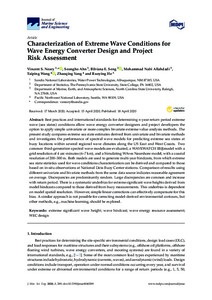| dc.contributor.author | Neary, V.S. | |
| dc.contributor.author | Ahn, S. | |
| dc.contributor.author | Seng, B.E. | |
| dc.contributor.author | Allahdadi, M.N. | |
| dc.contributor.author | Wang, T. | |
| dc.contributor.author | Yang, Z. | |
| dc.contributor.author | He, R. | |
| dc.date.accessioned | 2020-05-02T14:00:18Z | |
| dc.date.available | 2020-05-02T14:00:18Z | |
| dc.date.issued | 2020 | |
| dc.identifier.citation | Neary, V.S.; Ahn, S.; Seng, B.E.; Allahdadi, M.N.; Wang, T.; Yang, Z.; He, R. (2020) Characterization of Extreme Wave Conditions for Wave Energy Converter Design and Project Risk Assessment. Journal of Marine Science and Engineering, 8: 289, 19pp. DOI:https://doi.org/10.3390/jmse8040289 | en_US |
| dc.identifier.uri | http://hdl.handle.net/11329/1317 | |
| dc.identifier.uri | http://dx.doi.org/10.25607/OBP-825 | |
| dc.description.abstract | Best practices and international standards for determining n-year return period extreme
wave (sea states) conditions allow wave energy converter designers and project developers the
option to apply simple univariate or more complex bivariate extreme value analysis methods. The
present study compares extreme sea state estimates derived from univariate and bivariate methods
and investigates the performance of spectral wave models for predicting extreme sea states at
buoy locations within several regional wave climates along the US East and West Coasts. Two
common third-generation spectral wave models are evaluated, a WAVEWATCH III®model with a
grid resolution of 4 arc-minutes (6–7 km), and a Simulating WAves Nearshore model, with a coastal
resolution of 200–300 m. Both models are used to generate multi-year hindcasts, from which extreme
sea state statistics used for wave conditions characterization can be derived and compared to those
based on in-situ observations at National Data Buoy Center stations. Comparison of results using
different univariate and bivariate methods from the same data source indicates reasonable agreement
on average. Discrepancies are predominantly random. Large discrepancies are common and increase
with return period. There is a systematic underbias for extreme significant wave heights derived from
model hindcasts compared to those derived from buoy measurements. This underbias is dependent
on model spatial resolution. However, simple linear corrections can effectively compensate for this
bias. A similar approach is not possible for correcting model-derived environmental contours, but
other methods, e.g., machine learning, should be explored. | en_US |
| dc.language.iso | en | en_US |
| dc.rights | Attribution 4.0 International | * |
| dc.rights.uri | http://creativecommons.org/licenses/by/4.0/ | * |
| dc.subject.other | Extreme significant wave height | en_US |
| dc.subject.other | Wave hindcast | en_US |
| dc.subject.other | Resource assessment | en_US |
| dc.subject.other | WEC design | en_US |
| dc.title | Characterization of Extreme Wave Conditions for Wave Energy Converter Design and Project Risk Assessment. | en_US |
| dc.type | Journal Contribution | en_US |
| dc.description.refereed | Refereed | en_US |
| dc.format.pagerange | 19pp. | en_US |
| dc.identifier.doi | https://doi.org/10.3390/jmse8040289 | |
| dc.subject.parameterDiscipline | Parameter Discipline::Physical oceanography::Waves | en_US |
| dc.bibliographicCitation.title | Journal of Marine Science and Engineering | en_US |
| dc.bibliographicCitation.volume | 8 | en_US |
| dc.bibliographicCitation.issue | Article 289 | en_US |
| dc.description.sdg | 14.A | en_US |
| dc.description.eov | Sea surface height | en_US |
| dc.description.maturitylevel | TRL 8 Actual system completed and "mission qualified" through test and demonstration in an operational environment (ground or space) | en_US |
| dc.description.bptype | Manual (incl. handbook, guide, cookbook etc) | en_US |
| obps.contact.contactemail | vsneary@sandia.gov | |
| obps.resourceurl.publisher | www.mdpi.com/journal/jmse | en_US |
 Repository of community practices in Ocean Research, Applications and Data/Information Management
Repository of community practices in Ocean Research, Applications and Data/Information Management

